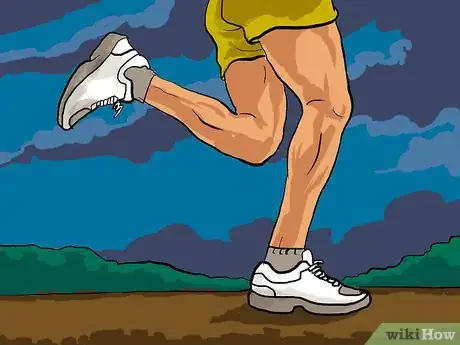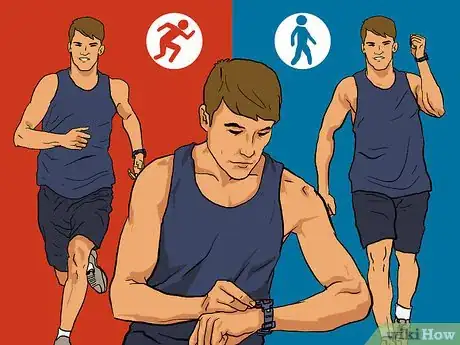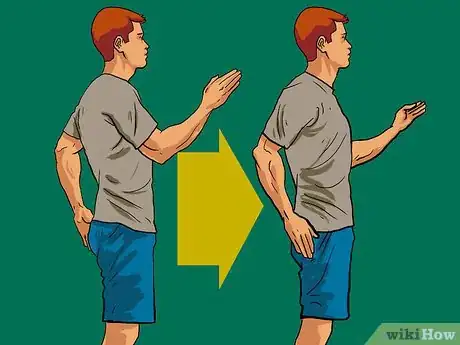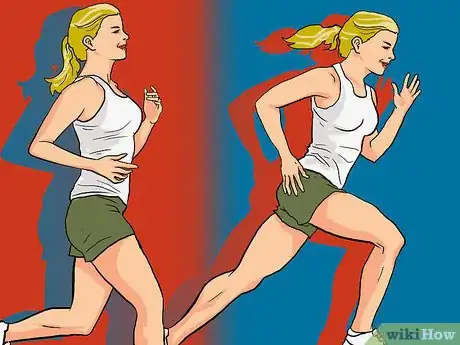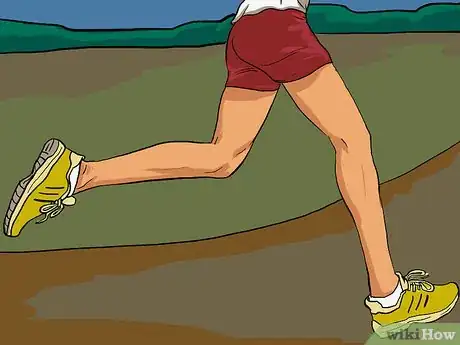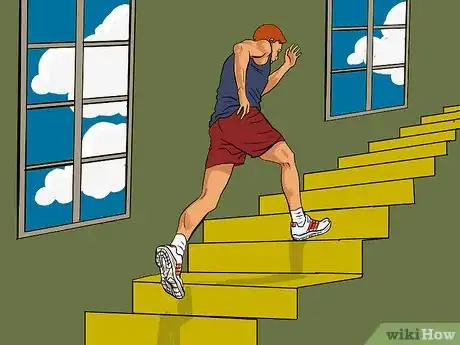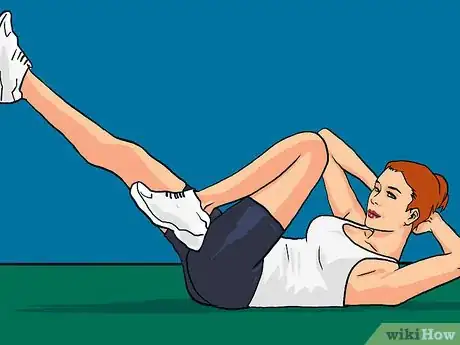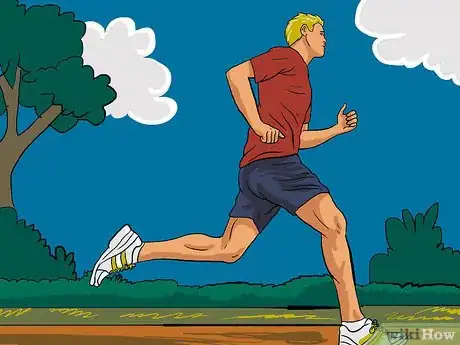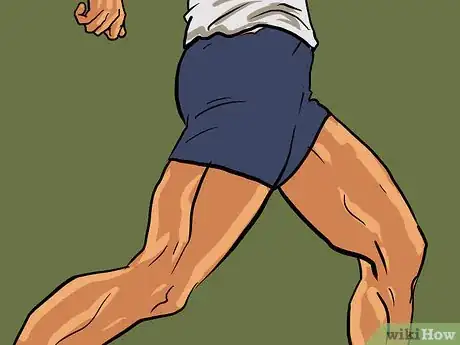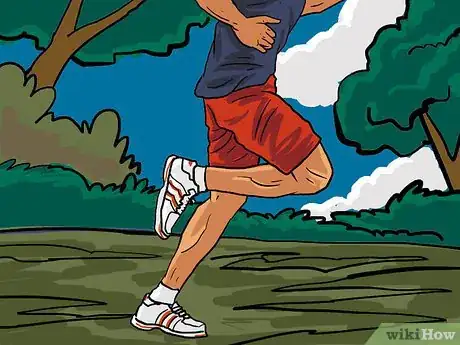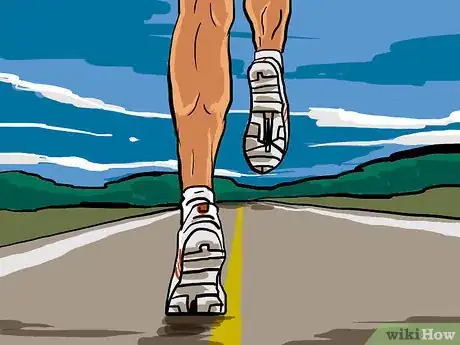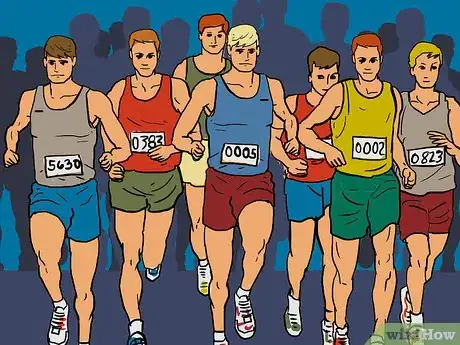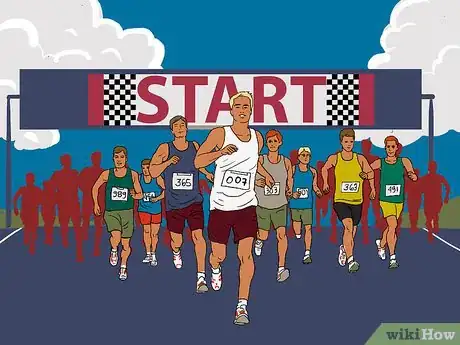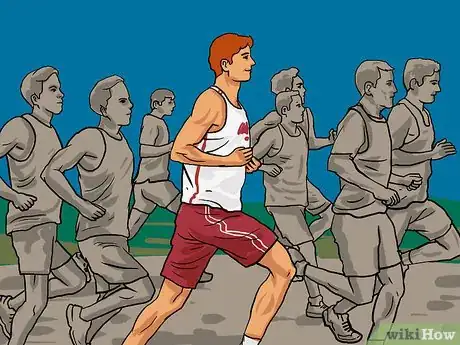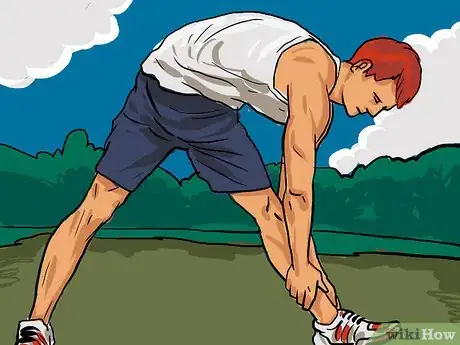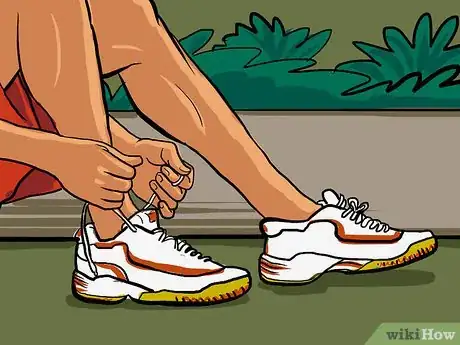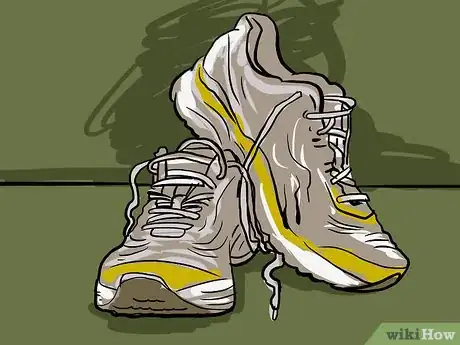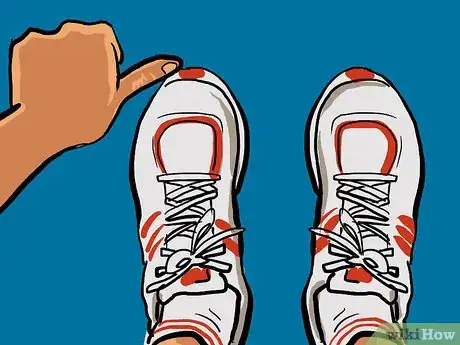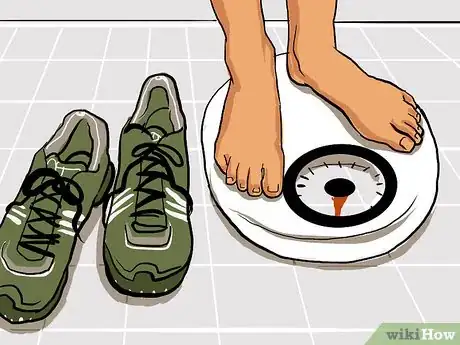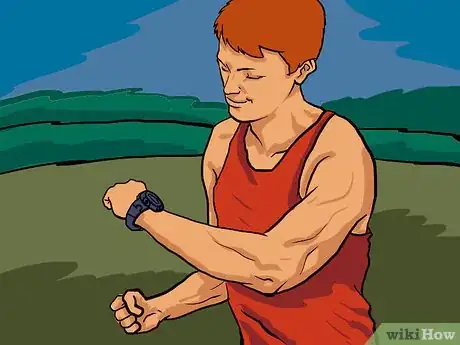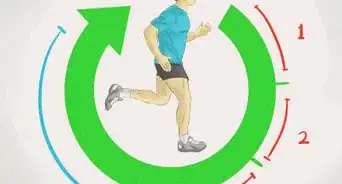This article was co-authored by Landis Owens. Landis Owens is a Personal Trainer and the Owner of Almighty Personal Training Studio in Tempe, Arizona. With over 15 years of experience in the health and fitness industry, Landis specializes in weight loss, nutrition, and core and strength training. Landis received a football scholarship to Mesa Community College where he studied Engineering and Sports and Exercise. He is an ISSA Certified Personal Trainer and also holds certifications in Nutrition, Youth Sports, Injury Stay Free, and CPR. Landis also competes in bodybuilding competitions.
There are 12 references cited in this article, which can be found at the bottom of the page.
This article has been viewed 305,659 times.
Whether you're trying to improve your mile time to become your high school track team's MVP, or you're trying to improve that time so you can successfully run a local 5K, anyone at all can improve his or her mile time with considerable hard work and effort. You'll need to improve not only your speed, but also your strength and endurance, keeping in mind that the faster your mile time is, the harder it will be to trim it down. If you want to get started on improving your mile time, see Step 1 to get started.
Steps
Running Better, Faster, Stronger
-
1Sprint shorter distances than the mile. It's time to get on the track and kick up your 800, 400, or even your 200 m time. (A mile is about 1600 meters long). Being able to run these shorter distances at a faster pace can help you run that mile faster. For example, if you've gotten your 800 time down to 3 minutes, then you won't be able to run your mile in 6 minutes due to the fact that you'll slow down because you'll be running for twice as long. It will help you get your mile time down significantly if you're used to running those 800s in 4 minutes. Here's how to do it:
- Do interval training for the 800. Run the 800 as fast as you can, and when you're done, walk 400 meters. Repeat until you've run the 800 4 times. Remember to pace yourself; your goal should be to hit all of those 800s at around the same time. Some people say that the 800 is the toughest race on the track because it requires both intense speed and endurance.
- Do interval training for the 400. Run a 400, walk for 200, run a 400, walk a 200, and so on, until you've run 6-8 400s.
- Do interval training for the 200. Run a 200, walk a 100, run a 200, walk a 100, and repeat until you've run at least 8 200s. Starting to see a pattern here?
-
2Do exercises to improve your arm speed. Having fast and strong arms is just as important as having strong legs. Here are some great exercises that can help you improve your arm speed:
- Do the standing arms drive. In the standing arms dive, all you have to do is open up your hands, keep your elbows at 90 degrees, and drive your elbows down and then move your arms back up, moving from chin to pocket, chin to pocket, as quickly as you can. Do 3 reps of 10-20 of these to improve that arm speed. You can even look at yourself in the mirror when you do this to make sure you are driving your arms forward and back.
- Do the sitting arms drive. Do the same thing with your arms as you would do during the standing arms dive, except be seated with your legs straight out in front of you instead of standing.
Advertisement -
3Do interval training. Interval training means sprinting and resting, sprinting and resting, for a distance shorter than a mile. Ideally, you can do this on a track. You should already be in pretty solid shape before you start interval training. As you get more comfortable, you can start off at a higher percentage of maximum effort. You can also run at the increased pace for longer; for example, you can run at a race pace for 2-3 minutes, cool down for 90 seconds, run at the race pace for 2-3 minutes, and repeat until you've done about 25-30 minutes of interval training. It's about the amount of time you run for, not the distance, so here is a sample interval training routine:
- 5 minutes of light warm up. Stretch afterwards.
- 30 seconds of increased pace (70-75% of maximum effort) followed by 2 minutes of running at a decreased pace.
- 30 seconds of increased pace (75-80% of maximum effort) followed by 2 minutes of running at a decreased pace.
- 30 seconds of increased pace (80-85% of maximum effort) followed by 2 minutes of running at a decreased pace.
- 30 seconds of increased pace (85-90% of maximum effort) followed by 2 minutes of running at a decreased pace.
- 30 seconds of increased pace (90-95% of maximum effort) followed by 2 minutes of running at a decreased pace.
- 30 seconds of increased pace (100% of maximum effort) followed by 2 minutes of running at a decreased pace.
- 5 minutes to jog and cool down.
-
4Do exercises to improve your leg strength. The stronger your legs are, the more power and endurance your legs will have, and the faster you'll be able to run that mile. Here are some ways to build strength in your legs:[1]
- Do uphill sprints. Instead of sprinting on the track, do your sprints uphill, running for 30 seconds to a minute at a time, and then walking downhill to recover for at least 1 minute before repeating the exercise. Do at least 10 uphill sprints at a time. This will build your strength, power, and your cardiovascular strength.
- Do leaps. For this exercise, leap as high as you can over objects such as soccer balls or cones for at least 50 feet (they can be imaginary objects, too). This can improve your power and your speed. After you've finished leaping for 50 feet, walk back to the starting line and repeat the exercise. Continue for at least 50 reps.
- Do knee kicks. Run in place for 30 seconds at a time, kicking your knees up as fast and high as you can, so they reach at least above your waist.
- Climb stairs. Run up stairs for 30 seconds to a minute, walk back down, and repeat at least 5 times. This is great for your cardio, too.
-
5Improve your endurance. The mile is both a speed and an endurance race, so it's important to have that endurance as well. The best thing you can do to improve your endurance is to, well, run for longer distances to train your body to stay strong throughout the mile. This doesn't mean that you should train for a marathon, but that you should be comfortable running a 5K at a good speed, or even a 10K.
- Mix up your workouts between speed training days and endurance training days. For example, one day, you can run 4 800s as fast as you can, and the next day, you can run 4 miles (6.4 km) at a good pace to work on your endurance instead of your speed.
- Remember that you can't really just improve one or the other. Even running 800s can help improve your endurance, just as running 5 miles (8.0 km) can improve your speed.
- When you go on longer runs, have a goal for each mile you want to hit -- be it 10 minutes, 12 minutes, or 15 minutes. Work on sticking to your goal instead of coming fast out of the gate and then struggling to finish by the end.
- Add some hills to your endurance training. If you throw some hills and difficult terrain into the mix, your endurance will build even more and it'll be easier for you to run the mile quickly when the time comes.
- If you get bored with running, you can improve your endurance by swimming, playing soccer or basketball, or doing anything that requires pretty continuous motion for 30 minutes or more.[2]
-
6Use hand weights. Hand weights can help you improve the strength of your arms and core and spending just 20 minutes a day with them can help you grow stronger, and therefore, faster. You can easily work out at home using hand weights. Take some light weights and work on a variety of exercises that can help you tone your biceps, triceps, forearms, and shoulders. You can do bicep curls, tricep kickbacks, or hammer grabs.
-
7Do other exercises to improve your strength. Though hand weights can be handy, you can also work out at home without using a single weight and quickly improve your strength. Here are some other exercises you can try:
- Squats. Standing straight up, squatting down, and then popping back up at least ten times in a row for three repetitions can help you strengthen those thighs.
- Push-ups. Push-ups can help you build strength in your biceps and triceps.
- Do ab work. Do sit-ups, crunches, or the bicycle to help yourself work your core and get stronger.[3]
Improving Your Technique
-
1Master the proper running form in your upper body. Running with the proper form will keep you from feeling fatigue and from using extra energy that you don't need to expend. This alone can help shave more than just a few seconds off of your mile time. Here are some form-musts you should know to keep your upper body strong as you run the mile:[4]
- Tilt your head correctly. Look ahead of you, at the horizon, not at your feet. This will help keep your neck and back straight, and it will be easier to breathe.
- Keep your shoulders low and loose. If your shoulders start moving up toward your ears when you get tired, shake them out to get rid of the tension that has been building up. It's important to keep your upper body loose and relaxed if you want to run as efficiently as possible.
- Use your arms as efficiently as possible. Keep your hands in an unclenched fist, swinging your arms back and forth, right between your waist and lower-chest level, keeping your elbows bent at a 90-degree angle.
- Keep your torso and back straight. Stretch yourself upwards to reach your full height while keeping your back straight and comfortable. Deep breaths can help you straighten your body when you get tired.
-
2Master the correct technique in your lower body. Your legs and lower body are just as important for running a fast mile as your upper body. Here's what you need to know to get the proper technique:[5]
- Keep your hips pointed forward. If you start to hunch over during a run, you'll put too much pressure on your back and you won't be running as quickly as you can.
- Lift your knees slightly when you run. This, along with a quick leg turnover, and a short stride, can help you run longer distances more quickly. Your feet should land beneath your body, with your knees slightly flexed so they can bend correctly when your feet hit the ground.
- Hit the ground lightly with your feet. Land your foot between your heel and mid foot and then quickly roll forward toward your toes, keeping your ankles flexed so you get more force out of the movement. Spring off the ground when you roll onto your toes, so that your calves push you forward with each step, keeping your moves quiet but springy.
-
3Breathe correctly. If you want to maximize your running potential, then you have to get the breathing part down. You should learn to breathe deeply, through your nose, and to release the air slowly out of your mouth. Nose breathing is difficult for some people, so you may need to work on it; if you breathe in through your mouth, you may find yourself gasping for air. Work on timing your breath to your steps, breathing in every 3 or 4 steps, so you fall into a rhythm. If you feel yourself getting of sync, just focus on your breath.[6] [7]
-
4Master your technique throughout the race. If you're running a mile on a track or during a race, then there are a few things you can do to improve your time during the course of the race, using the other runners to your advantage. Here are some things that you can do:
- Come out strong out of the gate. Get out faster and more powerfully, not letting all of the other runners get in front of you, which will make it harder for you to make your way up toward the front of the pack during the race.
- Know your position. If you're on a track team, you should have a sense of where you fall in with the crowd. If you're one of the fastest milers on your team, then yeah, you should start toward the front of the pack. If you're more on the slower side, then you should not start in the front because you'll be blocking the way of faster people, and you should find a good position in the middle of the group instead.
- Don't try too hard to be in the front. The runner in the front of the pack faces the most pressure throughout the race because he or she sets the pace for the rest of the group, breaks the wind, and feels the most pressure if other runners are right at his or her heels. Unless you are leaps and bounds faster than everyone else in the race, you should hang near the front, letting another person set the pace and looking for your opportunity to get ahead when you feel the front runner getting tired. This can happen as late as the last 400 or 200 m of the race.
- Stay relaxed in the middle of the race. Don't get tense in the middle of the race. Focus on your breathing, and keeping your body loose and limber as you propel forward.
- Maintain the best position on the track. If you're running on a track, a good rule of thumb is to pass on the straights, not the curves. Passing a runner on the curves is a waste of energy, because you'll have to run longer to get around that person than you would on a straight away. When you're running with a pack, try to stay toward the inside of the track, so you actually have to cover a bit less distance; this is a good strategy as long as you don't get crowded by other runners.
- Kick it at the end. During the last 100-200 m of the race, you'll really have to dig deep and get ready to run your heart out. Don't run out of energy and struggle to stay with the pack at this point; gather up your strength and speed up your usual pace. You may even feel like you're sprinting during the last straight of the race, and that's okay if that's what you have to do to win.
- Stay focused ahead of you. Don't look at your coach, your other teammates, or anyone else to the side or back of you, or you will be slowing yourself down.
-
5Warm up and cool down effectively. There are some schools of thought that say that stretching before and after your runs can help you run more quickly, prevent injury, and help your body get ready to run and to unwind from a workout. However, others believe that stretching actually tires the muscles and has no real benefits before a workout, and that just a few minutes of warming up can do the trick better.[8]
- If you decide to stretch your calves, hamstrings, and heels, then do a few simple standing and seated stretches.
- If you want to warm up before your run instead, then just jog for a minute or two, do some knee kicks, or run in place to get your heart rate up. Whatever you choose, it will get your body ready to run faster.
Running Smart
-
1Make sure you have the right shoes. One of the easiest ways to improve your mile time is to make sure that you're wearing appropriate footwear. This may seem irrelevant, but if you're running in shoes that are too old, too snug, too loose, or which just don't give you the correct support, then you may not be maximizing your potential. Don't be shy. Go to a running store, where a professional can help you find the best fit, and sometimes even watch you run to see what type of shoe would suit you the best. Here are some things to keep in mind when you consider buying new running shoes:[9]
- How long you've had the old pair. You should replace any pair of running shoes after running between 300–400 miles (480–640 km), which can translate into less than a year of running about 10 miles (16 km) a week, or a lot sooner if you used to them for marathon or half-marathon training. Running in shoes that are no longer in good shape will not only make it harder for you to run fast, but they can lead to injuries.
- Wiggle room. You should have at least a thumb's width of room between the end of your longest toe and the front of your shoe. Most people buy running shoes that are actually too small for them, so it's okay if it feels like you're wearing clown shoes, at first.
- A secure fit throughout the mid-foot. Your feet should feel pretty snug on either side.
- A secure fit throughout the heel. Slipping in this area can lead to injuries.
-
2Eat well. You should be eating well enough to give yourself plenty of energy for running, but not so much that you feel sluggish or tired. Don't eat less than an hour before your mile training, or you will feel sluggish and tied down. If you know you'll be doing some intense training on the track or sprinting, eat until you're about 2/3 full. You should eat foods that contain carbohydrates and that are easily digestible, and which will give you energy without weighing you down. Here are some things to keep in mind if you want to eat right to help yourself get faster:[10]
- It's all about balance. Though the right carbohydrates will give you energy, don't forget that protein or those fruits and veggies.
- If you're just training to improve your mile time, you do not need to load up on carbohydrates. Don't eat a heavy bowl of pasta before your run, thinking it will give you the energy you need.
- If you're looking to eat a snack that will help you train, try a banana, a peach, half of a Cliff bar, a piece of wheat toast, or an English muffin with jelly.
-
3Hydrate, hydrate, hydrate. Drink at least a 16 oz. glass of water an hour before your run, and make sure you consume at least 8-10 of these glasses throughout the day.
- In addition to drinking water, drinking a cup of coffee about 30 minutes to an hour before you run can make you go faster. However, don't try this for the first time on race day, or it can make you feel a little bit too jittery and can lead to some digestive issues.
-
4Lose weight if it's necessary. If you're at a healthy weight for your height and frame, then you don't need to try to lose weight at all. However, if you are carrying a little extra weight, it will slow you down because it will weigh your body down as you try to run your mile. Therefore, work on finding a healthy routine for weight loss while continuing to run regularly and eating foods that keep you strong.[11]
-
5Have company. Running with people who are at your speed, or preferably faster than you, can help you stay motivated and not slack off if you're getting tired. Whether you're on a track team, in a runner's club, or running 5Ks in your town as often as you can, just having the company of others can help you stay strong, think fit, and try to break your own records. And most of all, running with other people can remind you that while fitness is an important goal, so is having fun!
-
6Do time trials. Whether you're doing them with your track team or on your own, if you want to improve your speed, you should periodically time yourself when you run the mile, simulating the pressure you'd feel if you were running a real race. You don't have to time yourself every time you do the mile or you will put too much pressure on yourself, but you should do it at least once a week so you put the pressure on, put your body in adrenaline mode, and get ready to succeed. If you beat your PR (personal record), celebrate and think of all the things you do right, so you can continue to kick up your speed in the future.
-
7Set your own standards. If you're trying to be the start of your high school track team, then yeah, you can aim for running a 6-6:30 mile, or even a 5-5:30 mile. But if you're just trying to run a mile faster because you want to have fun and stay fit, then aiming for that 12 or 10 minute mile is a very impressive goal as well. You don't have to be Usain Bolt to feel good about how quickly you run, and you don't have to keep the pace with all the other runners around you if your body is screaming for you to slow down. It's great to improve your speed, but it's even more important to stay healthy and be proud of yourself for staying fit.
Community Q&A
-
QuestionWhat should I think about when running?
 Community AnswerThink about something you love, like a favorite artist, book, movie, or food, or sing songs you like in your head.
Community AnswerThink about something you love, like a favorite artist, book, movie, or food, or sing songs you like in your head. -
QuestionHow do I run 400m in under 4 minutes? I always get too tired half way through when I run.
 Joshua GumeroCommunity AnswerJust start by building up your endurance. 400m is a short distance, but it may seem very long for many people. So start by building your endurance, go out and just run 5 out of 7 days of the week. Your biggest goal is not walking, forget about time and just attempt to run for as long as you can. Go as slow as you need to, just no walking! Once you feel pretty comfortable running for about 2-3 minutes (just a mental approximation) without walking, then go on the track and time yourself. See what your result is, if you end up walking then it doesn't count and you'll just have to keep building up your endurance. If you finish the whole 400m without walking then give yourself a pat on the back.
Joshua GumeroCommunity AnswerJust start by building up your endurance. 400m is a short distance, but it may seem very long for many people. So start by building your endurance, go out and just run 5 out of 7 days of the week. Your biggest goal is not walking, forget about time and just attempt to run for as long as you can. Go as slow as you need to, just no walking! Once you feel pretty comfortable running for about 2-3 minutes (just a mental approximation) without walking, then go on the track and time yourself. See what your result is, if you end up walking then it doesn't count and you'll just have to keep building up your endurance. If you finish the whole 400m without walking then give yourself a pat on the back. -
QuestionDoes listening to music help when running?
 Community AnswerYes. Music can help. Music can help you ignore the fatigue, the feeling of needing to not run anymore or even pain. Hard metal tracks can boost your mood so much that you sometimes would prefer to continue for an extra mile.
Community AnswerYes. Music can help. Music can help you ignore the fatigue, the feeling of needing to not run anymore or even pain. Hard metal tracks can boost your mood so much that you sometimes would prefer to continue for an extra mile.
References
- ↑ http://www.fitday.com/fitness-articles/fitness/strength-training/5-speed-strength-training-exercises-to-try.html#b
- ↑ Landis Owens. Personal Trainer. Expert Interview. 8 June 2021.
- ↑ Landis Owens. Personal Trainer. Expert Interview. 8 June 2021.
- ↑ http://www.runnersworld.com/running-tips/perfect-form
- ↑ http://www.runnersworld.com/running-tips/perfect-form
- ↑ Landis Owens. Personal Trainer. Expert Interview. 8 June 2021.
- ↑ http://www.fitsugar.com/How-Breathe-When-Running-19967835
- ↑ http://www.runnersworld.com/stretching/should-i-stretch-my-runs
- ↑ http://www.runnersworld.com/running-shoes/how-buy-right-running-shoes
- ↑ http://health.usnews.com/health-news/blogs/eat-run/2013/09/05/what-to-eat-before-running
- ↑ http://www.fitbodyhq.com/cardio/how-to-run-a-faster-mile/
- http://www.fitbodyhq.com/cardio/how-to-run-a-faster-mile/
- http://www.runnersworld.com/workouts/magic-mile?page=single
- http://sealgrinderpt.com/crossfittraining/tips-to-improve-your-mile-run-time.html/
- http://www.military.com/military-fitness/running/improve-your-pft-mile-time
About This Article
To improve your mile time, start by doing interval training where you sprint for 800 meters, then walk for 400 meters. Repeat until you've run the 800 four times, and work towards hitting the same time for each 800 to build speed and endurance. Additionally, improve your arm speed by doing standing arm drive drills or lifting free weights. You’ll also want to improve your leg strength by running up hills, leaping as high as you can for at least 50 reps, and climbing stairs. To learn how to improve your mile time by mastering proper running form, keep reading!
